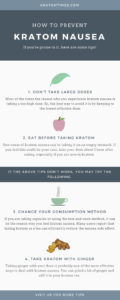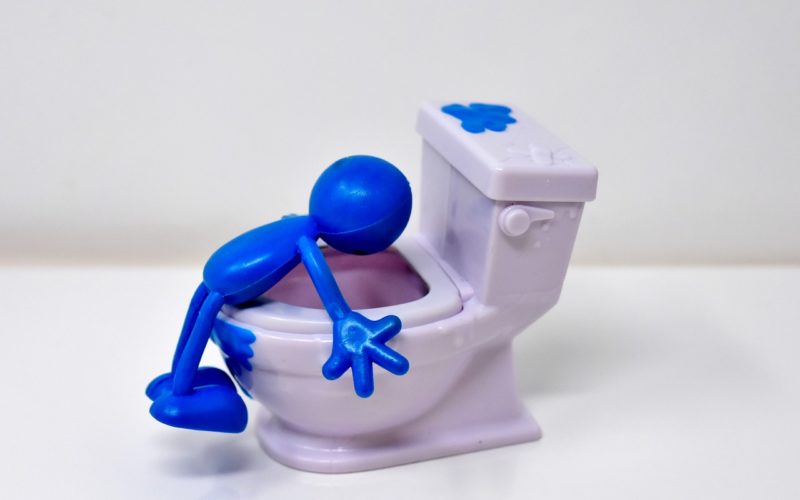In recent times kratom’s popularity has risen noticeably. This is thanks to its wide range of properties and effects including pain and anxiety relief, energizing and stimulating. That’s why many people have turned to kratom to help them ease the symptoms of many conditions, such as fibromyalgia or depression or to alleviate the symptoms of opiate withdrawal.
But, like every other product, natural or not, kratom doesn’t come without side effects. One of the most common side effects of kratom is kratom nausea. In this article, we’ll explore why this occurs, how to prevent it and how to alleviate it when it’s already present.
What is Nausea?
The Merriam Webster Dictionary defines nausea as a stomach distress with distaste for food and an urge to vomit. Nausea occurs when we feel the necessity of vomiting or emptying our stomach. As such, nausea usually happens as a precursor to vomiting, although this is not always the case. To empty our stomach, our brain needs to send a message to our digestive system otherwise, vomiting won’t occur.
Nausea sometimes comes accompanied by other symptoms, that can include:
- Headache
- Sweating
- Dizziness
- Fever
Also, when the cause of nausea is a digestive problem, you may experience stomach or intestinal spasms.
Nausea typically goes away on its own, although there are natural and over-the-counter remedies to help get rid of it.
What Causes Nausea?

Although nausea is a typical symptom of digestive problems, they are not the only ones that can cause it. In fact, most times nausea is triggered by other factors or conditions. The most frequent causes of nausea are certain food intolerances, migraines, and some infectious diseases. Also, some metabolic disorders, such as hyperthyroidism, and some conditions that affect the equilibrium organ in the inner ear can activate the vomiting center of the brain. Moreover, pregnant women typically get nausea in the first three months of pregnancy.
But there are many other factors that can trigger nausea, for example:
- Motion sickness
- Emotional stress
- Stomach flu
- Overeating
- Heart attack
- Concussion
- Food poisoning
- Certain medications
- A reaction to strong odors
- Drinking too much alcohol
- Intense pain
- Some forms of cancer
What Is Kratom Nausea?
One of the most frequent side effects of kratom is kratom nausea, and it can be very unpleasant. Like any other type of nausea, you feel kratom nausea when the vomiting center of the brain is activated, then, you feel the urge of emptying your stomach. And sometimes, kratom nausea can make you vomit, which is not ideal if you want to enjoy kratom’s effects.
Typically, the strains that are more likely to provoke kratom nausea are the Bali and Indo varieties. So, if you tend to feel kratom nausea, try to avoid these strains.
Why Do You Get Kratom Nausea?

There are individuals that are more prone to feel kratom nausea than others. Whilst some people will never experience this side effect, there are others that will feel it almost immediately after taking their kratom dose. But there are certain factors that can trigger kratom nausea, such taking a too large dosage or taking kratom on an empty stomach.
Nevertheless, there are some measurements that you can take to prevent kratom nausea.
How to Prevent Kratom Nausea?
Although every individual is different and what works for some may not work for others, there are some general tips that you can follow to prevent kratom nausea. Keep reading to discover them below:

Don’t Take Large Doses
Most of the times the reason why you experience kratom nausea is taking a too high dose. So, the best way to avoid it is by keeping to the lowest effective dose. Always measure your doses to avoid taking too much kratom. A good start point would be taking 1 gram and, if you don’t feel the effects, you can add another gram an hour later. Stop when you feel the effects that you are looking for to avoid overdosing. Also, consider taking regular kratom powder instead of kratom extracts, as the latter can be harder on the stomach.
Eat something before taking kratom
Another cause of kratom nausea can be taking it on an empty stomach. If you feel this could be your case, always take your dose about 1 hour after eating, especially if you are new to kratom. But if you are an experienced kratom consumer and still feel nausea, you can try to eat a light meal, i.e.: a yogurt, before your dose. In any case, don’t eat too much, as this could also increase the possibility of developing kratom nausea.
Change your method of consumption
If you are taking capsules or using the toss and wash method, it can be the reason why you feel kratom nausea. These methods make it more difficult for the stomach to digest the substance. Many users report that taking kratom as a tea can efficiently reduce the nausea side effect.
Take your kratom with ginger
Taking ginger with your dose is probably one of the most effective ways to deal with kratom nausea. You can grind a bit of ginger and add it to your kratom tea. Or if you prefer, you can chew a bit of ginger root just after taking your dose to prevent kratom nausea.



